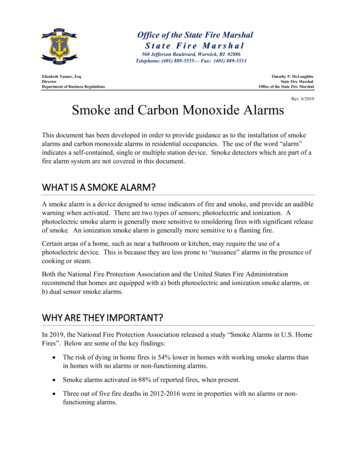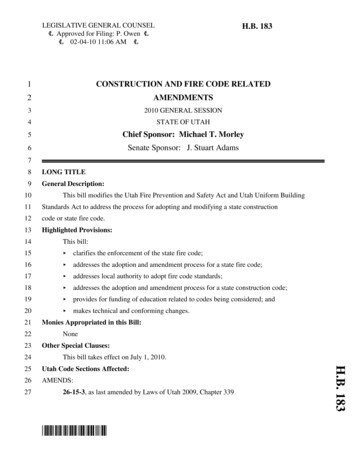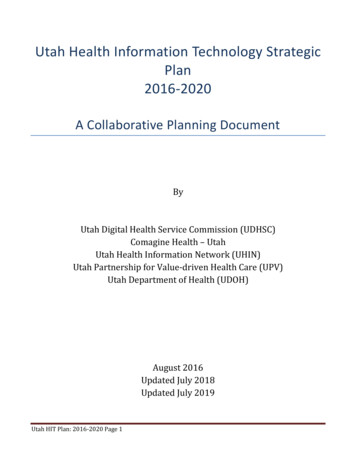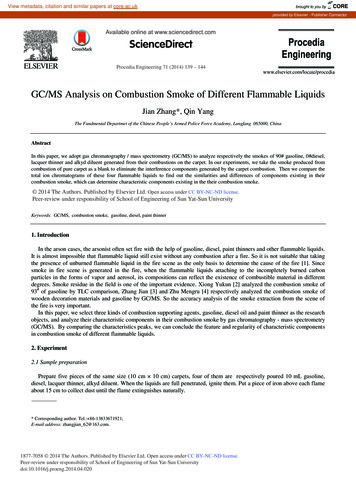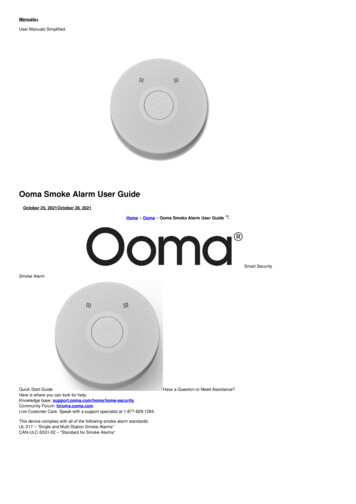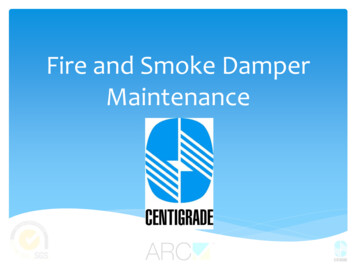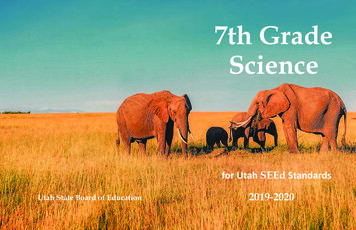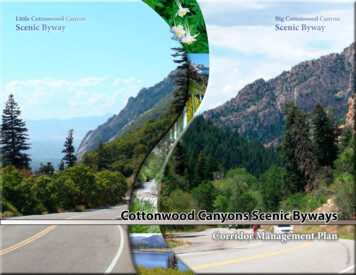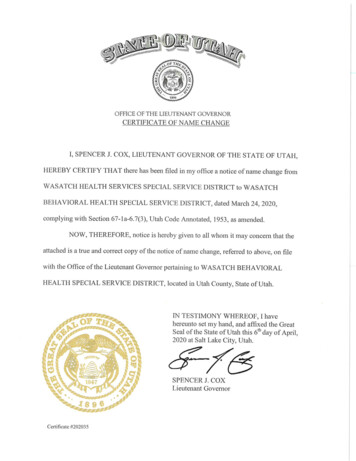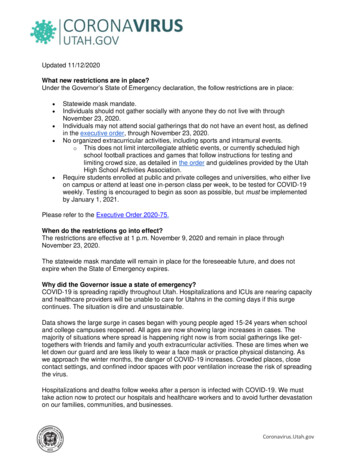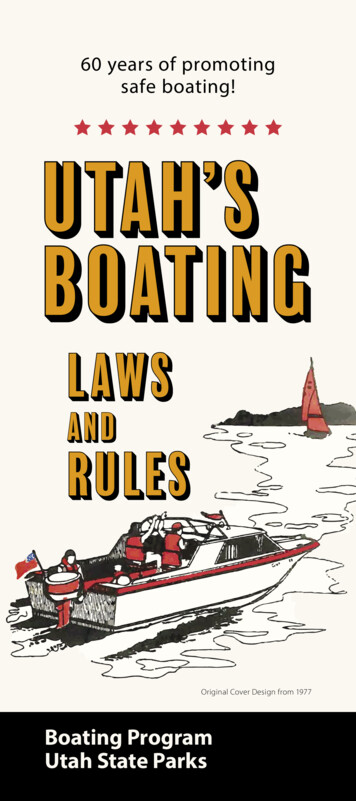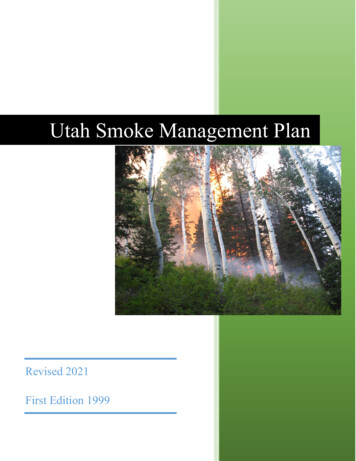
Transcription
Utah Smoke Management PlanRevised 2021First Edition 1999
Utah Smoke Management Plan1.BACKGROUND . 12.PURPOSE. 23.GOALS . 34.SCOPE . 35.ORGANIZATION AND OPERATING PROCEDURES . 46.PRESCRIBED FIRE REQUIREMENTS . 57.WILDFIRE REQUIREMENTS . 78.MITIGATIONS . 79.PROGRAM MANAGEMENT . 910.DEFINITIONS. 10Appendix A - Dispersion, Avoidance, and Emission Reduction Techniques . 13Appendix B - Utah Enhanced Smoke Management Plan . 141. BACKGROUNDUtah’s first Smoke Management Plan (SMP) was originally developed in 1999. This document is athorough update to the SMP driven by the following reasons:1. Large fires are increasing in severity and frequency.2. Smoke substantially affects regional air quality and accounts for a disproportionate numberof unhealthy days, both nationally and in the state of Utah. 1, 23. State leadership and land managers increasingly recognize that prescribed fire is one ofmany important techniques that can maintain healthy landscapes and reduce the risk ofcatastrophic wildfire 3, thereby minimizing overall smoke impacts. While mechanical fuelreduction has increased greatly since 1999, fire is still a key tool.4. A great number of tools for smoke forecasting have been developed in the last 20 years,with applications for prescribed fire and wildfire. The SMP is being modernized torecognize these tools, allow greater flexibility in decision making, and improve riskanalysis of impacts on local population.In making prescribed fire permitting decisions, risk analysis will include a greater emphasis on populationproximity to proposed burns. Of the 1,300 proposed prescribed fires in Utah in the years 2015 through2019, 986 (75%) were in locations with a population density of 10 or fewer people per square mile. Ofthose 986 remote burns, 714 (72%) are located above 6,000 feet. For high elevation and/or remoteprescribed fires, smoke produced may be less likely to impact communities.Cascio, W.E. Wildland fire smoke and human health. Science of The Total Environment 624, 586-595 (2018)Larsen, A.E., Reich, B.J., Ruminski, M., Rappold, A.G. Impacts of fire smoke plumes on regional air quality, 2006–2013. J Expo Sci Environ Epidemiol 28, 319–327 (2018)3Catastrophic Wildfire Reduction Strategy 0213.pdf121
This map shows Utah’s population centers in relation to prescribed fires conducted from 2015-2019. Because asignificant amount of prescribed burning is located in remote areas, and frequently at high elevation, greaterflexibility can be allowed for those projects with respect to the clearing index.2
2. PURPOSEThis SMP identifies the responsibilities of federal and state land managers and the Utah Division of AirQuality (DAQ) to coordinate procedures that mitigate the impacts of prescribed fire on air quality,visibility, and public safety, in terms of smoke. This plan is designed to meet the requirements of theRegional Haze Rule, 40 CFR 51.309(d)(6), the policies of the U.S. Environmental Protection Agency’s(EPA) Interim Air Quality Policy on Wildland and Prescribed Fires, and to serve as a guide for TitleR307, state administrative rule for air quality.On November 8, 1999, the EPA approved the original Utah SMP under the regional haze stateimplementation plan (SIP). Subsequent changes to the SMP may require a SIP revision to verify that theSMP continues to meet requirements of the regional haze rule. The SMP may be revised and resubmittedfor approval to EPA with the concurrence of the DAQ and all signatories to the statewide masteragreement (SMA) for wildland fire.3. GOALSTo balance the need to minimize smoke impacts on air quality, public safety, and visibility with the needto allow prescribed fires and wildfires to accomplish land management objectives, including catastrophicwildfire risk reduction, hazardous fuel reduction, vegetation management, wildlife habitat improvement,and other ecological functions.To develop a system for reporting and coordinating burning operations on all forest and range lands in theState.To develop an emission inventory for pollutants of interest based on reporting of prescribed fire andwildfire events.To quantify the use of alternative methods to burning for disposing of or reducing the amount of wildlandfuels on lands in the State.4. SCOPEThe SMP serves as an operational plan for the state administrative rule, R307-204, by providing directionand operating procedures for all organizations involved in the management of prescribed fire.R307-204 establishes the procedures and the permitting process that land managers are required to followto mitigate the impact of smoke on air quality and visibility in the State. Utah state implementation plansfor regional haze and particulate matter rely on emission reduction credits from this rule.The Utah Enhanced Smoke Management Plan, Appendix B of the SMP, provides details on the visibilityrequirements of the regional haze rule and operating procedures to reduce visibility impacts from smokein Class I areas.There is a Utah statewide master agreement for wildland fire, which includes an annual operating plan.This covers smoke management and spells out shared roles and responsibilities, including that thesignatories agree to abide by the provisions of this SMP. The signatories are: US Forest Service, Bureauof Land Management, National Park Service, US Fish and Wildlife Service, Bureau of Indian Affairs, andthe Utah Division of Forestry, Fire, and State Lands.3
The SMP also applies to landowners who use prescribed fire on lands where the Department of NaturalResources (DNR) provides fire protection during the June-October fire season, with the exception ofprescribed fires less than 20 acres and permitted through the DNR’s Division of Forestry, Fire and StateLands.This plan does not apply to agricultural burning and open burning as defined by Utah Code 19-2-114.Lands that have been classified as Conservation Reserve Program (CRP) lands, and are adjacent toagriculture lands, will be treated as agricultural lands and will not have to abide by the requirements ofthe SMP. However, those CRP lands that are adjacent to federal or state lands will be required to abideby the requirements of the SMP.5. ORGANIZATION AND OPERATING PROCEDURESUtah’s smoke management program is a cooperative effort between the DAQ and the agencies thatmanage prescribed fire. The organizational structure consists of the Utah air oversight committee, theUtah airshed group, and a smoke program coordinator. Each signatory to the SMA has full membershipin the airshed group.The air oversight committee consists of the senior management of the signatories to the SMA,plus the director of DAQ. Funding for the coordinator position and support functions will beprovided as agreed upon by the air oversight committee.The airshed group is comprised of leaders from the land management agencies, a DAQrepresentative, and the smoke program coordinator. The airshed group meets at least once a yearto:1. Provide overall management direction and guidance to the coordinator by functioning as aninteragency steering committee to ensure appropriate implementation of the SMP;2. Review and evaluate the results of the previous burning season, de minimis burning, andfuture prescribed fires;3. Review procedures in the SMP and make revisions if necessary;4. Advise on appropriate boundaries for airsheds;5. Work towards resolving interagency, inter-airshed and inter-state smoke problems; and6. Review operating costs of the smoke management program.The smoke program coordinator (coordinator) is responsible for the daily operation andmanagement of the SMP. Specifically, the role of the coordinator is to:1. Act as liaison and facilitate communication with all participating agencies;2. Perform smoke mitigation analysis to ensure requested prescribed burns will not cause orcontribute to a NAAQS violation;3. Evaluate pre-burn and burn request information, meteorological data, and cumulativesmoke effects. Based on this, recommend burn approval, conditional approval, ordisapproval to the DAQ director (director);4. Communicate the director’s decision to the land manager;5. Review and evaluate dispersion and emission reduction techniques (Appendix A),encourage the use of technology to assess and mitigate smoke impacts;6. Coordinate with counterparts in other states, both on day-to-day operations and long-termissues;4
7. Manage a database of prescribed fires, emissions and emission reduction techniques fromdata submitted by land managers. This will be used to create an annual report (due April15 of the following year) and to document contribution to NAAQS violations, if any;8. Prepare and disseminate information on prescribed fire, wildfire, and air quality;9. Provide smoke management training for agencies; and10. Receive direction and oversight from the Utah airshed group and oversight committee.6. PRESCRIBED FIRE REQUIREMENTSThis section outlines the reporting requirements for land managers when conducting prescribed fires.A. Small Prescribed Fires (de minimis).This category is for prescribed fires less than 20 acres/day and pile burning less than 30,000 cubicfeet/day. It is intended for projects that have negligible air quality impacts. An annual review ofthis category is conducted by the airshed group. The following requirements apply:1. The land manager shall notify the coordinator on the morning of the day of ignition.2. Ignition can occur when the National Weather Service clearing index is 500 or greater.3. With approval of the director, ignition may occur when the National Weather Serviceclearing index is between 400 and 499:a. This approval is based on fuel type, tons of emissions, proximity to sensitive receptors,downwind values, distance from other burning, current and forecast air quality, andnumber of requests to burn within the airshed.b. To request approval, the land manager is required to notify the coordinator with theabove information via email or phone by 0800 hours the morning of the burn. Thecoordinator will make a recommendation to the director, and contact the burner withthe decision.c. If approved for burning with a clearing index below 500, the prescribed fire burn bossshall submit to the coordinator: hourly photographs, an hourly description of the smokeplume, hourly meteorological conditions, and a record of any smoke-relatedcomplaints. This can be done with the standard form for prescribed fire weather/smokeobservations (Utah prescribed fire plan template appendix G) or equivalent.B. Large Prescribed FiresThis category is for prescribed fires covering 20 or more acres and pile burns with 30,000 or morecubic feet of material per day. Three forms are required for large prescribed fires: pre-burninformation, burn requests, and emissions reports. Land managers may also elect to submit thoseforms for small prescribed fires (defined above).1. Pre-burn. Land managers shall submit pre-burn information to the coordinator at least oneweek before the burn window. This will be done through the online system or email. Thisis only required once for each prescribed fire project. In the event of changes or updates tothis information, the land manager shall notify the coordinator. Required informationincludes:5
a. Project name, acres, and latitude and longitude;b. Summary of burn objectives, fuel types, and ignition methods;c. Any sensitive receptors within 15 miles, including any Class I area, nonattainment area,or maintenance area, with distance and direction in degrees from the project site;d. The emission reduction techniques to be employed (Appendix A), smoke dispersionmodels used and results, and estimated total amount of particulate matter;e. A map depicting both the daytime and nighttime smoke path and down-drainage flowfor a minimum of 15 miles from the burn site with smoke-sensitive areas delineated;f. Any other information needed by the director for smoke management purposes, or forassessment of contribution to visibility impairment in any Class I area; andg. An electronic copy of the burn plan including these elements: prescription, resources,smoke management, contingencies and/or management action points, public andpartner notifications, and safety.2. Burn Request. Land managers are required to submit a burn request to the coordinator by1000 hours two business days before the planned ignition of a large prescribed fire. Therequest should come through the online system or email. Burn requests shall include thefollowing information:a.b.c.d.Project name consistent with the pre-burn information;Start and end dates for the burn window, up to seven consecutive days;Number of total acres for the burn window and estimated acres per day; andComments or any other information needed by the director for smoke managementpurposes.The coordinator will make a recommendation to the director, who will issue a decision,either approving, approving with conditions, or denying burning by 1600 two business daysbefore the beginning of the planned ignition. The burn approval decision will be giventhrough the online system or email. If a land manager is not notified of the burn approvaldecision by 1600 hours, it is his/her responsibility to contact the coordinator or director todetermine if burning is authorized.The burn approval decision made by the director will be made using all availableinformation regarding the prescribed burn. The criteria for making burn approval decisionsinclude, but are not limited to:a.b.c.d.e.f.Proximity to populated areas and sensitive receptorsSmoke and emissions modelingForecast meteorological conditionsAnalysis of the emissions from prescribed fires in progress and proposed;Analysis of non-fire factors that may affect attaining the NAAQS;Analysis of the emissions from wildfires, including smoke transported from areasoutside of Utah, to ensure cumulative smoke effects do not violate NAAQS;g. Existing and predicted local air quality;h. Protection of visibility in Class I areas as required by the regional haze rule (40 CFR51.309(d)(6);i. Minimization of smoke impacts in Class I areas, roads or highways, airports, areas thatare nonattainment, or other sensitive areas; andj. Other factors relating to protection of the NAAQS pursuant to 40 CFR Part 50.6
The burn approval decision made by the director can be rescinded at any time, as outlinedin Section 8, Part A of this plan. Once a burn request has been approved by the director, thenotification of ignition falls on the land manager. The land manager must contact thecoordinator by phone, text, or email each day of the burn window during which ignitionwill take place.3. Emission Report. Within two business days of completing ignitions, land managers arerequired to submit an emission report for each day of large prescribed fire activity to thecoordinator. The daily emission report will be used by the coordinator to generate anannual report of fire activities. The report will include the following information:a. Date of ignition for the prescribed fire;b. Forecasted clearing index for the airshed or from a spot weather forecast;c. Total affected acres, actual black acres or number of piles burned, and a calculation ofPM2.5 emissions;d. Public interest regarding smoke, daytime smoke behavior and comments, and nighttimesmoke behavior, if witnessed; ande. Emission reduction techniques (ERTs) applied and evaluation of the effectiveness ofthe ERTs.C. Annual Burn ScheduleLand managers proposing to burn more than 50 acres per year are required to submit to thecoordinator an annual burn schedule by March 15th each year. Each agency will work with thecoordinator to do this at the level they deem appropriate, i.e. forest-wide, district-wide, etc. Thefollowing information shall be included for all prescribed fires, including those smaller than 20acres:1. Project name;2. Acres for the year, expected burn dates and burn duration; and3. For projects without pre-burn information already submitted: latitude, longitude, fuel type,and planned use of emission reduction techniques.This information may be used in state implementation plan development. Land managers willalso report their annual accomplishments of non-fire treatments that can be consideredalternatives to burning. The coordinator will compile the statewide schedule, includingalternatives to burning, and submit it to the DAQ each year by April 15th.7. WILDFIRE REQUIREMENTSLand managers will notify the DAQ of wildfires. The coordinator will review the incident managementsituation report during fire season. Wildfire and prescribed fire emissions will be monitored for impactson air quality and visibility and to track emissions for inventory and regulatory purposes.8. MITIGATIONSA. Management of Ongoing Fires: If, after consultation with the land manager(s), the directordetermines that a prescribed fire, wildfire, or any emission from other sources is degrading airquality to levels that could violate the National Ambient Air Quality Standards, he/she may7
rescind approved burn requests, and the land manager(s) will promptly stop igniting newprescribed fires and work with DAQ to most effectively mitigate current smoke emissions fromfires already burning.B. Public Notification/Education: The coordinator, land managers, and DAQ will be responsible forproviding the following public notification and education related to the SMP, with the responsibleparty is indicated in parenthesis:1. Recent, current, and upcoming prescribed fire projects, location, size, and responsibleagency (coordinator, land managers);2. Smoke impacts of wildfires and prescribed fires (coordinator, land managers);3. The role of prescribed fires and wildfires in accomplishing land management objectives(land managers);4. Issuing air quality alerts as appropriate (DAQ);5. Education on the health effects of smoke (coordinator, DAQ); and6. General contact information for the program (coordinator).C. Compliance: Land managers conducting a prescribed fire will permit DAQ staff to enter andinspect burn sites before, during and after burns, to verify the accuracy of the permit or prescribedfire plan information and compliance with the burn plan, if appropriate. Site inspectionprocedures will be coordinated with the prescribed fire burn boss and land manager for safetypurposes prior to any site inspections.All parties are committed to comply with the Clean Air Act and the best management practicesavailable regarding emission production, reduction, and regional haze issues. Failure to complywith the procedures and conditions specified in state administrative rule or conditional approvalmay result in an enforcement action, such as a cease and desist order. The National WildfireCoordinating Group Interagency Prescribed Fire Planning and Implementation Procedures Guideand agencies have direction for any Air Quality Notice of Violations (NOV) and provisions andrequirements for reviews.D. Monitoring: Land managers will document effects of the prescribed fire on sensitive receptorsand visibility in Class I areas. Documentation of smoke may be recorded on the form included inthe Utah Interagency Burn Plan Template, or from a general fire behavior log. Nuisance smokecomplaints by the public should be passed on to the coordinator as well as noted and recorded inthe project file. DAQ staff will forward to the land manager any complaint calls that are receivedregarding smoke.For large fires expected to last more than one day, or fires close to sensitive receptors, locatingreal-time particulate matter monitors at sensitive receptors may be warranted. The DAQ mayassist in identification of instrumentation, site selection, installation of instrumentation, operation,calibration, quality assurance, quality control, laboratory analysis, and data interpretation.Land managers will document pertinent information that may lead to improved future operationsand a better understanding of smoke accumulation problems, impacts, and solutions. This will beincluded in the emission report that is submitted to the coordinator.8
9. PROGRAM MANAGEMENTFormsSmoke management forms are on the smoke management system: www.smokemgt.utah.gov.Preferably, all forms should be submitted through the online system. PDF alternatives will beavailable from the coordinator.Annual Burn Schedule. Due by March 15th each yearPre-burn information. Due one week before first burn windowBurn request. Due by 1000 two business days before planned ignitionEmission Report. Due by 1000 two business days following the burnContact Info (Current as of 2021)DirectorSmoke Program CoordinatorBryce BirdDivision of Air Quality195 North 1950 WestSalt Lake City, UT 84116Paul CorriganUS Forest Service857 S. Jordan ParkwayS. Jordan, UT 84095801-440-1350paul.corrigan@usda.govUtah Airshed GroupGreg BartinNational Park Service(435) 772-7847greg bartin@nps.govDon MitchellBureau of Indian Affairs(435) 724-2593donald.mitchell@bia.govBrook ChadwickUS Forest Service(801) 999-2148james.chadwick@usda.govDusty RichardsDepartment of Natural Resources(435) 896-1628dustinrichards@utah.govLinda ChappellUS Forest Service(801) 625-5505linda.chappell@usda.govTracy SwensonU.S. Fish & Wildlife Service(435) 734-6449tracy swenson@fws.govJoel KarmazynDivision of Air Quality(801) 536-4423jkarmazyn@utah.govJ. Bradley WashaBureau of Land Management(801) 539-4246bwasha@blm.gov9
10. DEFINITIONSAirshed - A part of the atmosphere that behaves in a coherent way with respect to the dispersion ofemissions.Air Quality - The characteristics of the ambient air (all locations accessible to the general public) asindicated by concentrations of the six air pollutants for which national standards have been established(e.g., particulate matter, sulfur dioxide, nitrogen dioxide, ozone, carbon monoxide, and lead), and byvisibility in mandatory Federal Class I areas. For the purposes of this Smoke Management Plan,concentrations of particulate matter are taken as the primary indicators of ambient air quality.Annual Emissions Goal - The annual establishment of a planned quantitative value of emissionsreductions from prescribed fire.Burn Window - The period of time when the prescribed fire is scheduled for ignition.Conservation Reserve Program (CRP)- CRP is a land conservation program administered by the FarmService Agency. In exchange for a yearly rental payment, farmers enrolled in the program agree toremove environmentally sensitive land from agricultural production and plant species that will improveenvironmental health and quality. Contracts for land enrolled in CRP are 10-15 years in length. The longterm goal of the program is to re-establish valuable land cover to help improve water quality, prevent soilerosion, and reduce loss of wildlife habitat.Class I Areas - An area set aside under 42 U.S.C. 7491 to receive the most stringent protection from airquality degradation. Mandatory Class I Federal areas are: 1) international parks, 2) national wildernessareas which exceed 5,000 acres in size, 3) national memorial parks which exceed 5,000 acres in size, and4) national parks which exceed 6,000 acres and were in existence on August 7, 1977. The extent of amandatory Class I Federal area includes subsequent changes in boundaries, such as park expansions.There are five Class I areas in Utah: Zion National Park, Bryce National Park, Capitol Reef NationalPark, Arches National Park, and Canyonlands National Park.Clearing Index - An indicator of the predicted rate of clearance of ground level pollutants from a givenarea. This number is calculated by the National Weather Service from daily measurements of mixingdepth and average windspeed in the mixed layer.De minimis - Something so small, whether in quantity, importance, or severity, that it is exempt fromcertain government rules and regulations.Duff - The partly decayed organic matter on the forest floor.Emission - The act of discharge into the atmosphere of an air contaminant or an effluent that contains ormay contain an air contaminant; or the effluent so discharged into the atmosphere.Emission Reduction Techniques (ERT) - The techniques for controlling emissions from prescribed firesto minimize the amount of emission output per unit or acre burned.Director - The director of the Utah Division of Air Quality.Fuel Loading - The amount of fuel present expressed quantitatively in terms of weight of fuel per unitarea.10
Land Manager - Includes any federal, state, local or private entity that administers, directs, oversees orcontrols the use of public or private land, including the application of fire to the land.Maintenance Area – An area that has been re-designated by EPA from nonattainment to attainment of anyNational Ambient Air Quality Standard.National Ambient Air Quality Standards (NAAQS) - The standards for maximum acceptableconcentrations of pollutants in the ambient air to protect public health with an adequate margin of safety,and to protect public welfare from any known or anticipated adverse effects of such pollutants (e.g.,visibility impairment, soiling, materials damage, etc.) in the ambient air. National standards have beenestablished for particulate matter, sulfur dioxide, nitrogen dioxide, ozone, carbon monoxide, and lead, andare specified in 40 CFR Part 50.Nonattainment Area - An area which is shown by monitored data or which is calculated by air qualitymodeling (or other methods determined by the Administrator, EPA to be reliable) to exceed any NationalAmbient Air Quality Standard for such pollutant and includes any area designated as nonattainment under42 U.S.C. 7407.Oversight Committee - A group composed of senior fire management representatives of the agencies withwildfire management responsibilities in Utah: Bureau of Indian Affairs, Bureau of Land Management,National Park Service, US Forest Service, US Fish and Wildlife Service, and Utah Division of Forestry,Fire, and State Lands. For smoke program decisions this committee is termed the “Utah Air OversightCommittee”, and includes the DAQ director.Particulate Matter - The liquid or solid particles such as dust, smoke, soot, or dirt found in air emissions.Pile - Natural materials/debris resulting from some type of fuels management practices that have beenrelocated either by hand or machinery into a concentrated area.Pile Burning - Burning of individual piles.Prescribed Fire/Prescribed Burn - A wildland fire originating from a planned ignition in accordance withapplicable laws, policies, and regulations to meet specific objectives.Prescribed Fire Plan/Burn Plan - A plan required for each fire application ignited by management. Plansare documents prepared by qualified personnel, approved by the agency administrator, and includecriteria for the conditions under which the fire will be conducted (a prescription). Plan content variesamong the agencies.Prescribed Fire Prescription - The measurable criteria during which a prescribed fire may be ignited tomeet the prescribed fire objectives. The prescription will describe a range of low-to-high limits for theenvironmental or fire behavior parameters (or both) required to meet prescribed fire objectives. Onlythose parameters needed to identify the acceptable prescription window to meet prescribed fire objectivesshould be described. In addition to the prescribed fire objectives, the prescription should take intoconsideration constraints such as smoke management issues and perimeter control concerns.Smoke Management - Includes but is not limited to techniques to reduce emissions and smoke impacts, toidentify and avoid sensitive receptors, to monitor and evaluate the smoke impacts of each burn, and tocoordinate among land management agencies to minimize cumulative impacts.11
Sensitive Receptors - Population centers such as towns and villages, campgrounds and trails, hospitals,nursing homes, schools, roads, airports, mandatory Class I Federal areas, nonattainment areas, areaswhose air quality monitoring data indicate pollutant levels that are close to health standards, etc. wheresmoke and air pollutants can adversely affect public health, safety and welfare.Wildfire – A wildland fire originating from an unplanned ignition, such as lightning, volcanos,unauthorized and accidental human caused fires, and prescribed fires that are declared wildfires.Wildland Fire - Any non-structure fire that occurs in vegetation or natural fuels. Wildland fire includesprescribed fire and wildfire.Wildland Fuel - Combustible naturally occurring plant materials.12
Appendix A - Dilution, Avoidance, and Emission Reduction TechniquesEach land manager conducting prescribed fires will implement as many emission reduction anddispersion techniques as feasible for individual prescribed
Utah's smoke management program is a cooperative effort between the DAQ and the agencies that manage prescribed fire. The organizational structure consists of the Utah air oversight committee, the Utah airshed group, and a smoke program coordinator. Each signatory to the SMA has full membership in the airshed group.
